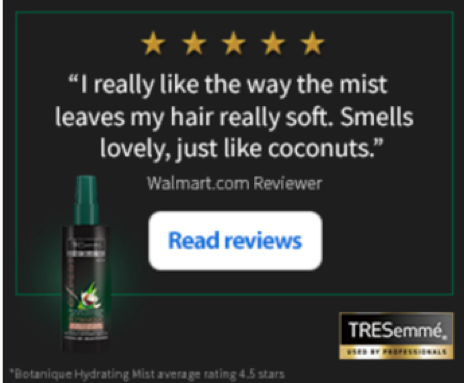September 26, 2017
For a lot of brands, selling through retailers is everything, and figuring out how to maximize your channel sales is a daily struggle.
But when it comes to maximizing those channel sales, brands face a few pain points. We know this, in part, because earlier this year we launched Bazaarvoice Brand Edge. During our research and development of Brand Edge, we homed in on those pain points and found one that kept coming up: Brands that depend on retailers for all or most of their sales have limited visibility into their customers. And because of that, they struggle to know how to influence retail shoppers.
That’s kind of a big deal. With few or no consumer touch points, quite a few brands are stripped of a key source of knowledge about who’s buying their products. That often makes it hard for brands to directly engage with their customers. It also means a lot of brands end up becoming more than a little dependent on retailers for marketing.
It doesn’t have to be this way. There are ways brands can engage with customers at the point of purchase; there are ways brands can interact with customers after the purchase; and there are ways brands can interact with people before they purchase anything.
Below, you’ll find four ways brands can engage with customers and up their channel sales game.
1. Let your customers talk to you
Here’s a novel idea: Talking with your customers is a good thing. Even brands that only sell their products through retailers should be interacting one-on-one with their customers, and it isn’t as hard as you think it is. It’s 2017, and social media is a thing — just check out Twitter’s own guide on how companies should use social media, and you’ll find more than a few prime examples of a brand talking with its customers.
The point here is to open an avenue of communication with your customers. Your customers are out there talking about your products — on social media, to their friends, in product reviews. The question is — are you listening?
To quote the age-old relationship advice, communication is key. When customers can directly ask you questions or bring up concerns, you’re in a far better position to answer them. And when you’re the one answering the questions, you cut out the middleman and have a far better chance of getting the right answers to the right person at the right time.
And sometimes, seeing how your customers are talking about your product in real-world language can be elucidating. But more on that later.
2. Give people a way to talk honestly about your products
Giving customers a way to talk to you is one thing, but giving them a way to talk to each other is just as important. From more organic online communities on Reddit to advocate programs that brands and retailers help guide, this past decade has seen an explosion in avenues consumers use to talk to one another.
But there’s a simpler way to give your customers a way to talk: ratings and reviews.
In the last six months, Digital Commerce 360 found that 93% of consumers turned to product reviews before making a purchase. And we’ve found that when customers have product reviews and other kinds of consumer-generated content (CGC) at hand, they’re 106% more likely on average to buy something from a retailer.
CGC impacts both online and in-store purchases. In our most recent ROBO (Research Online, Buy Offline) Report, we found that 82% of shoppers say they consult their phones about a purchase they’re about to make in a brick-and-mortar store. Online ratings and reviews translate into offline gains for brands.
Whether you have e-commerce on your website or sell solely through retailers, ratings and reviews are critical for engaging and influencing shoppers. If your brand is focused on channel sales, there are easy ways to implement ratings and reviews on your channel partners’ e-commerce sites.
3. Put real people in your channel sales marketing mix
It’s one thing to sit in a meeting room with a bunch of marketers and pontificate about the perfect marketing copy to sell products to customers. But it’s another to actually go and find out how your customers are talking about your products in real-world language. More often than not, there’s some distance between the two.
Put another way: People don’t like canned marketing messages as much as they used to. A study from Harris Poll and Lithium Technologies found that millennials and Generation Z are turned off by traditional advertising — as well as ads in their social network news feeds. Instead, younger generations trust sites and sources with product reviews, with 85% of respondents saying as much. Another study from Nielson found that 92% of consumers trust peer recommendations over advertising.
The bottom line: People trust their peers over marketers and advertisers.
But ads and product reviews don’t have to be disparate things — they can be combined in a way that wouldn’t make Frankenstein blush.

Just look above: After Unilever, the company behind TRESemmé, incorporated customer reviews into their ads, it measured a 20-30% improvement in performance. And this isn’t an isolated example.
The reason behind that jump in performance is pretty simple, according to Andy Crestodina, the co-founder of the award-winning web design firm Orbit Media Studios. Speaking with Bazaarvoice, Crestodina put it succinctly: “A testimonial or review makes the visitor a witness of a third-party endorsement. Think about it this way: Without a testimonial or review, a page is just filled with unsupported marketing claims — things that anyone could say.”
But when you put testimonials and reviews inside your marketing assets, advertisements, or even on your web pages, they offer support to all your marketing claims. And that’s pretty compelling stuff for potential customers considering your products.
Crestodina continues: “Have you ever seen a study that said a page is too compelling? That it has too much evidence?”
Exactly.
4. Identify and reward your advocates
In everything in a life, there’s always someone who’s a super fan. Mayonnaise? Yeah, there’s a super fan for that. The rock band, Kiss? Oh, they have hordes of super fans.
What we’re trying to say is that you’ve either already got some fans or you have some fans in the making. And it should be your goal to identify and reward them — because your biggest fans make the best advocates.
Here’s how you do that:
- Figure out what customers have bought things from you in the past and reacted positively to your products. You can do this by consulting reviews, social media (don’t forget YouTube!), your own CRM, or just using Google to see if people are talking about you.
- Reach out to these people and thank them personally for their purchase and kind words. Then, ask if they want to try out any other products you’re currently selling and offer them samples in exchange for some feedback (trust us, sampling is a tried-and-true method that works wonders). The prize here is two-fold: You’re recognizing someone who already likes your product (and presumably your brand) and you’re offering them the chance to try more things.
- If they pull through, send them a sincere thank you note and highlight their efforts in whatever way you can (maybe, for instance, on social media). That sets the cycle moving again and turns a one-to-one interaction between you and an advocate into something others can see.
Why would you spend time with people you already know are customers? By recognizing and rewarding customers who already like your products, you’re building brand loyalty and setting yourself up to get even more customers through their advocacy.
All of this hinges on having a way to interact with customers at and after the point of purchase. To learn more about how Bazaarvoice makes it easy for brands to engage with customers and increase channel sales at retail e-commerce sites through ratings and reviews, download our Guide to Better Retail Sales.





